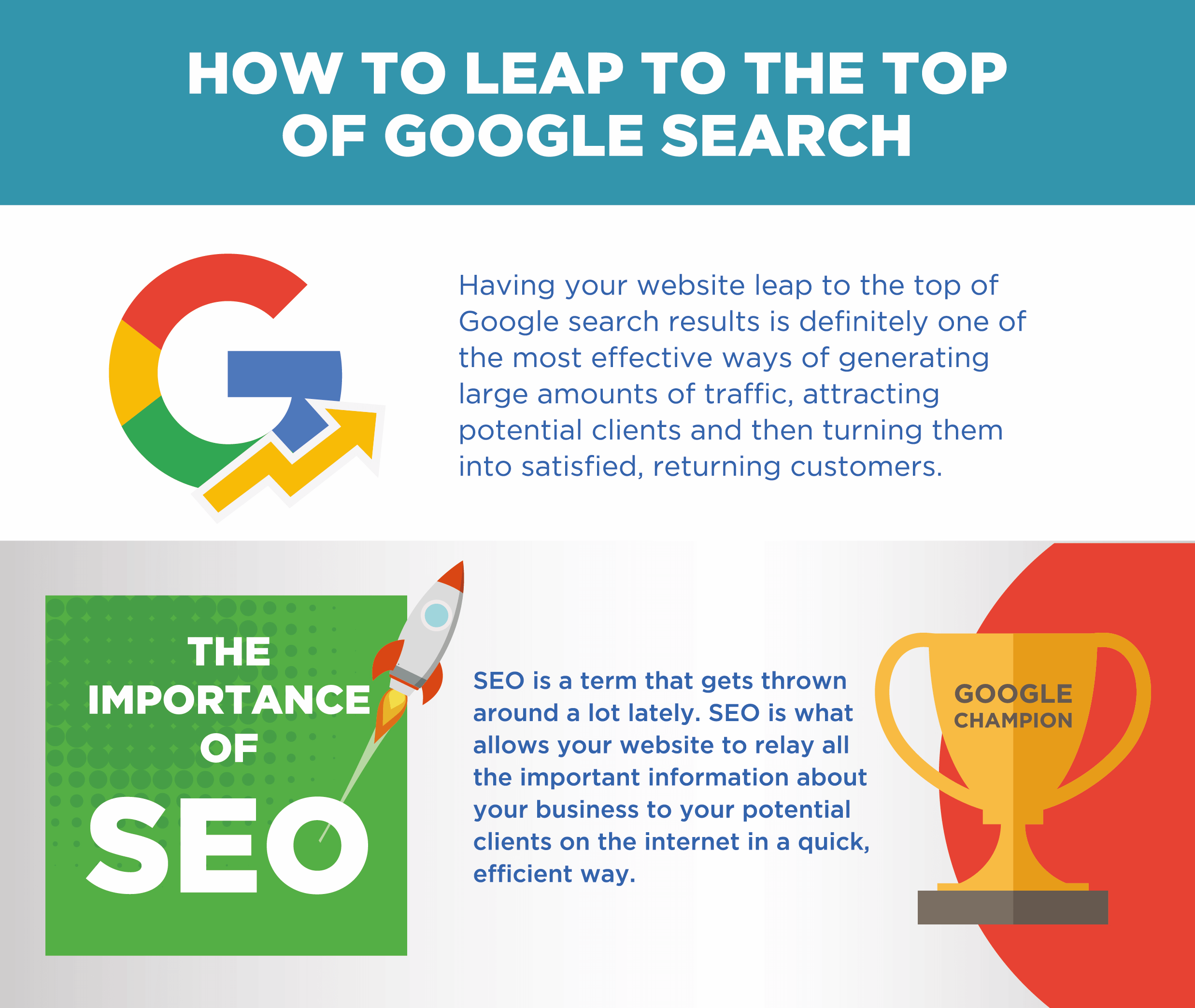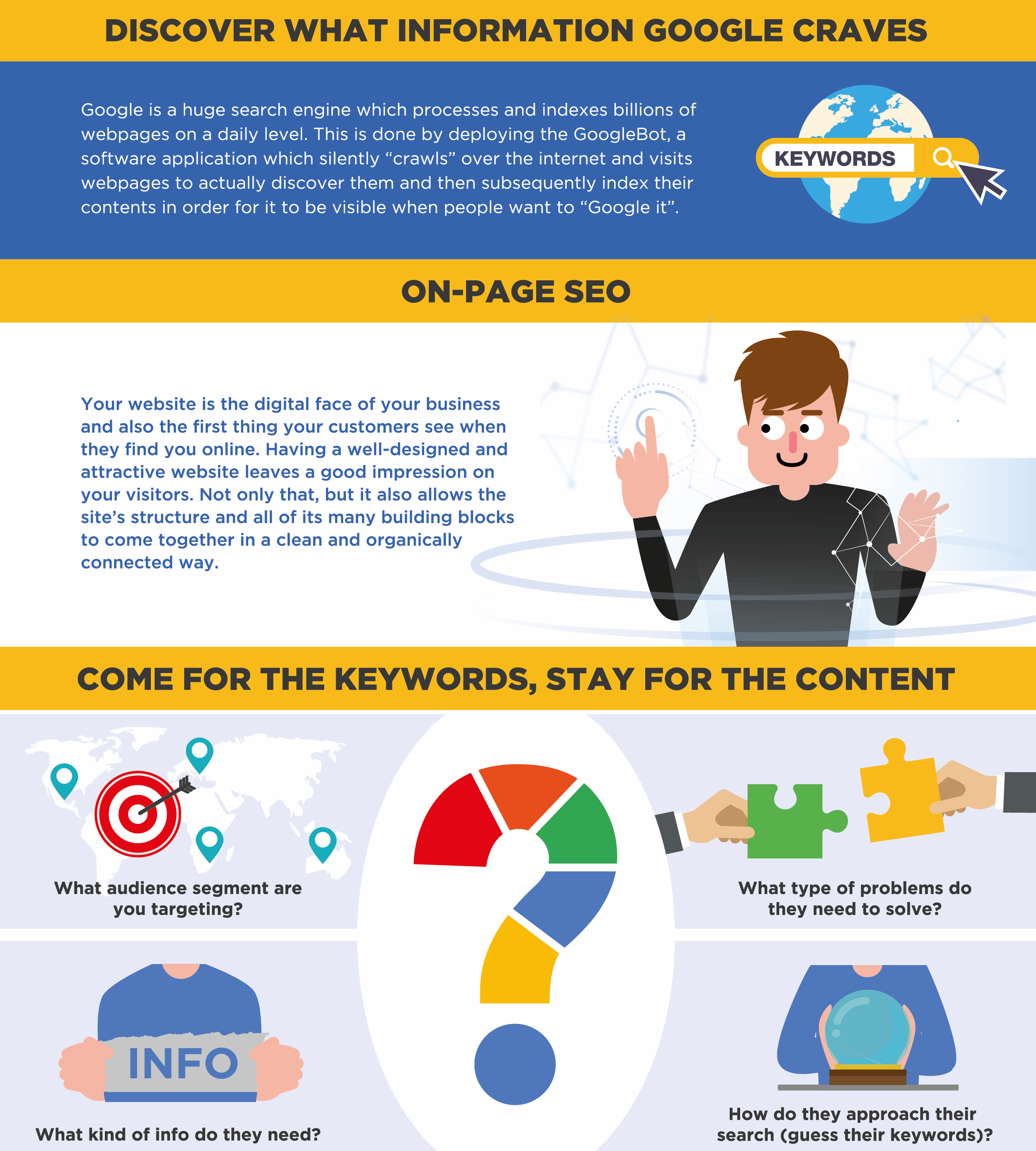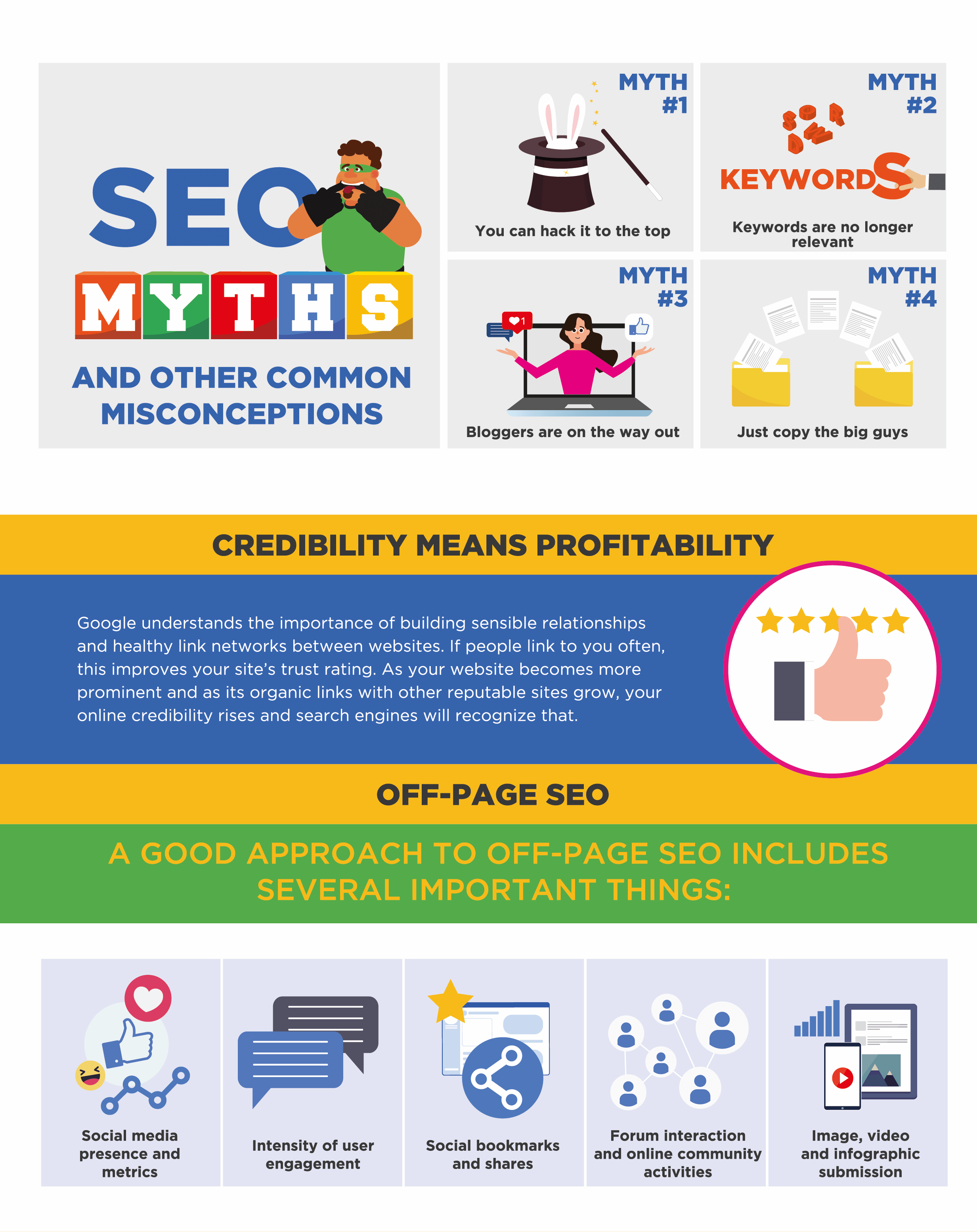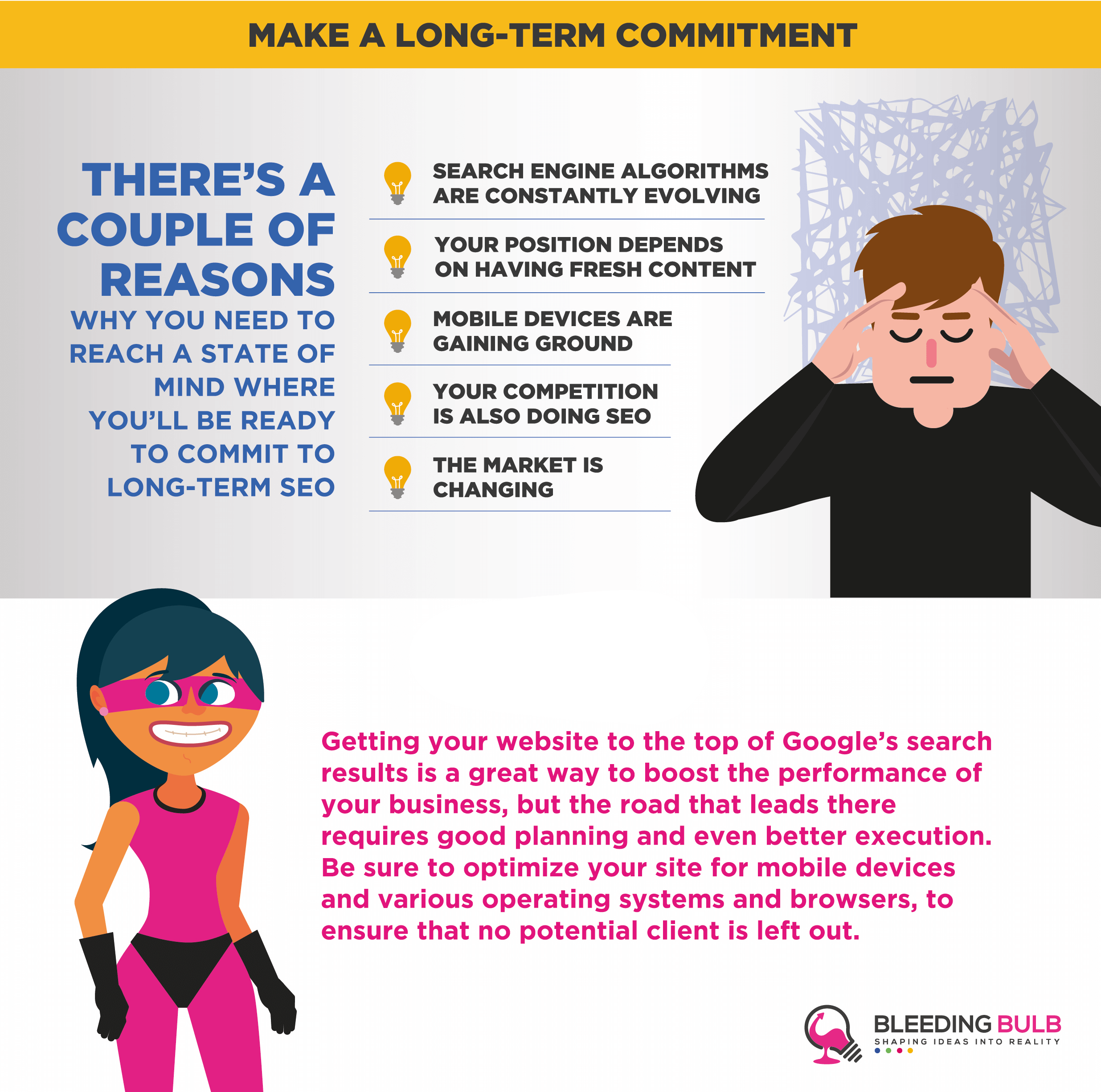Discover what information Google craves
Come for the keywords, stay for the content
SEO myths, hacks and other common misconceptions
Credibility means profitability
Introduction
Having your website leap to the top of Google search results is definitely one of the most effective ways of generating large amounts of traffic, attracting potential clients and then turning them into satisfied, returning customers. Let’s say you’re looking for a plumber who works Sunday emergencies, or browsing for holiday ideas, or simply trying to find the closest store where you could get that spare part for your PC.
When you type your query into Google, you’ll notice that the first page of results you get back corresponds pretty well with what you’re looking for. You click on one of the top links on that first search page, and a few moments later you’ll likely be able to fix your problem, get your information or make your purchase. If you’re wondering how those links on the first page of Google search results list got there, it’s time you got acquainted with SEO, short for Search Engine Optimization.

The importance of SEO
SEO is a term that gets thrown around a lot lately. Moreover, people often try to make it out to be this overly technical monster, but it’s really quite simple. SEO is what allows your website to relay all the important information about your business to your potential clients on the internet in a quick, efficient way. Keep in mind that SEO is not a thing you just do one time, and then your business magically skyrockets the day after.
Instead, SEO is a comprehensive process which consists of several very important elements, and knowing how these elements work and interact is essential for understanding how to approach building your website and your overall digital presence. You need to fit these pieces together so that Google, as the world’s most powerful and popular search engine, understands what you and your business are all about. It also helps Google connect you with potential customers to the mutual benefit of all parties involved.
The main value that an SEO-optimized website brings to your business is not just plain visibility on the web, but actual relevance of your business offer to your potential customers. It is precisely this pairing that will allow you to welcome customers to your digital or physical shop, help them feel at home and ensure that they leave with their needs fully satisfied.
Discover What Information Google Craves
Google is a huge search engine which processes and indexes billions of webpages on a daily basis. This is done by deploying the GoogleBot, a software application which silently “crawls” over the internet and visits webpages. GoogleBot discovers pages and then indexes their contents so it can be visible when people want to “Google it”. So, if you have a website, chances are that Google has already crawled over it, but you can always check whether the contents of your website have been indexed. Indexing lets Google know what your website is all about.
To check if your site is indexed or not, simply open your internet browser and input the name of your domain by typing site:yourwebsitename.com into the Google search box – just replace “yourwebsitename” with your actual domain name. If Google opens a list of your website’s pages, you’re good to go. However, if it so happens that you get no results back, then you’ll have to use the following link to let Google know you actually have a website with some content on it: http://www.google.com/addurl.
Submitting your website to Google for indexing is a good approach for anyone who’s just deployed their webpage and wants to be visible as soon as possible. If you’re interested in learning more about how Google search works in just a bit over three minutes, you can hear it straight from the source. Keep in mind that as soon as Google crawls and indexes your site, it will continue to do so periodically. It strives to understand all the content of your webpages and help you to be visible and relevant to your audience, but it can’t really work miracles. You’re responsible for providing Google with pertinent information and feeding it appropriate content, so that it can accurately index your site and present it to all who search for it.
You want Google to understand what you do, and Google needs to know your website info is well organized and easy to categorize. Keywords are what let Google know what your website is about. Your chosen keywords need to be realistic, to the point, and relevant to the business you are in. A great way to decide which keywords to use would be to analyze what you offer, and then compare that not only to what your customers ask of you, but also how they ask for it.
If you can figure out how potential customers phrase their questions while interacting with you in person, it’s extremely likely that they will type something similar into Google when searching online. Once you’ve taken care of all this, the next step is to make your webpage run as smoothly as possible and use Google’s technology to your advantage. This brings us to on-page SEO.

On-page SEO
Your website is the digital face of your business and also the first thing your customers see when they find you online. Having a well-designed and attractive website leaves a good impression on your visitors. Not only that, but it also allows the site’s structure and all of its many building blocks to come together in a clean and organically connected way. If you’re just getting started, you should consider investing in robust website architecture with a pleasant and intuitive visual design. This is an excellent way to ensure Google understands the site’s structure and recognizes the story behind it. It won’t cost that much, but it will definitely pay dividends as your online business activities continue to grow.
If you run your own website, this gives you great control over its technical features and the overall quality of the content that you post there. Furthermore, setting up solid infrastructure early on will give you a head start once you start building your links and start your off-page SEO efforts. A concisely engineered website allows both Google and your customers to navigate it easily. The desired content can be easily found, and then quickly linked to appropriate destinations in order to steer your clients towards products or services, and ultimately generate sales and revenue.
Strive to build a rich user experience which will make your customers feel comfortable and eager to come back. Make sure to optimize your landing page – you want it to pop and be striking, yet remain classy and crisp, without excessive and unnecessary content. It needs to hook the visitor and increase their staying time, while also offering what they originally came for. Focus on the core value proposition of your business and state what you offer and how it meets your clients’ needs. This is where you get to use those keywords and phrases we mentioned earlier; and remember to pay attention to titles.
Typically, the closer your keyword is to the beginning of your title tag, the happier Google will be when it indexes your page. Besides the overall look of your website, you should also take into account the site’s loading speed. Nobody likes a website with sluggish response times, cluttered pages and chaotic navigation that leads to broken links and endless redirects. Make sure everything is flawlessly connected and that there are no broken links between your pages. Everything needs to flow seamlessly. The URLs on your pages should be kept short and sweet, since they’re much more attractive to search engines that way. Moreover, if you’re linking to your own videos or other links on your website, try to name these links in accordance with the information they convey. They should be crafted so that they’re easily readable to humans and machines alike.
In addition, it’s recommended to use lower case letters: focus on one or two keywords related to the topic and avoid repetition of these words in the URL. Finally, since a growing number of people now browse the web on their mobile devices, make sure your website is optimized for a full mobile experience. Having a non-responsive design which ultimately forces mobile-based visitors to use the desktop version of a webpage will drastically diminish the visitors’ user experience and make them less likely to return.
Come for the Keywords, Stay for the Content
The keywords on your website might be one of the major factors that will initially bring you traffic, but no one is going to bother coming back to your website unless you have premium content that adds value. Your content should be pertinent to your visitors’ needs, easily accessible and engaging. When creating your content, try to answer the following questions:
What audience segment are you targeting?
What kind of info do they need?
What type of problems do they need to solve?
How do they approach their search (guess their keywords)?
Hosting various types of content on your webpage will improve your website’s organic offer, and is likely to direct more traffic your way. Think of Google image or video search, alongside the basic textual queries. Multimedia is always welcome, but should be used in moderation and tailored to the needs of your business – one carefully placed video clip is certainly better than a dozen irrelevant ones. Videos are a very reliable and effective way to engage people, get your message across and showcase your enterprise in just a few minutes. They have also been shown to boost dwell time when they’re present on the landing page.
The style in which your content is written is also quite important. Try to make it fluff-free and go straight to the point. Don’t be afraid to link to some topics and sources which could expand or deepen the information which can be found on your website. Aligning with similar or complementary content is an effective way to organically embed your business in a value chain. Your clients can come to you for their primary needs, but might end up visiting some of your affiliates or partners through your link referrals. Regarding website visits and referrals, we need to talk about “bounce rate”. Bounce rate shows the percentage of your website’s visitors that enter your site and then quickly leave, instead of staying to browse your content.
Depending on the nature of your business, having a high bounce rate could be either good or bad, but this indicator is quite important in any scenario. If you want to sell directly through your website, then you want people to enter and stay at least until their purchase is done. This means that a low bounce rate would work to your advantage. However, if your entire business model is based on referring visitors to another website where they do the actual purchase, then a high bounce rate seems like a good thing – but only if these visitors bounce to the right place. So, whichever way the bounce goes, just make sure it works to your advantage. If not, see what you need to do to optimize your bounce rate.
Hosting podcasts is a rising trend nowadays, so don’t be shy to incorporate these into your website if they’re a fit with the nature of your business. This also applies to infographics – everyone appreciates a straightforward breakdown of crucial information in visual form. After all, people are far more likely to adopt facts and statistics if they can create visual associations. Integration with social media is another plus and you can get widgets for linking up with Facebook posts and discussions, as well as with your own Facebook page. This can create a seamless experience for your users and give them a platform to browse and share ideas and opinions related to your business.
SEO myths and other common misconceptions
There is a lot of material online that talks about SEO and how to get to the top of Google. Unfortunately, a large amount of it is clickbaity, oversimplified or just plain wrong. If SEO is being portrayed as something that can be done overnight or hacked, you are being mislead. There is no magic bullet or quick fix. Here are some of the most common misconceptions about SEO.
Myth #1: You can hack it to the top
You must have heard people talking about “hacking” your way to the top of Google’s rankings, and boosting search engine stats through various tricks, ploys and made-up software sorcery. This is one of the most common myths related to your online presence and it feeds on one’s desire to get to the top easily and become an overnight sensation.
Optimizing your website’s position isn’t something that can happen in a matter of days. The sooner you understand this, the better you will become at actually putting in the proper effort which will push your page to the top of Google’s search results. For any reputable search engine, content is what matters the most – this is the essence of their job and the purpose of their software and algorithms. SEO is not a one-time effort, and embracing the business philosophy of being in it for the long haul will ultimately pay off.
Myth #2: Keywords are no longer relevant
Another myth that needs to be done away with is that keywords are no longer relevant, and that you shouldn’t spend time on researching which ones best fit your business. Keywords are still the most basic indicator that a search engine uses to identify websites and their content, but this has been expanded to include a broader context. Of course, you should be mindful not to oversaturate your website with the same keywords, because Google can tell that you’re trying to cheat it, and will not deem your page to be as relevant for its search. This also applies to your anchor texts.
Myth #3: Bloggers are on the way out
There is an unsubstantiated claim which somehow managed to go viral some time ago, and that was that guest blogging was no longer a viable SEO tool. This claim is simply untrue and has been thoroughly debunked since it first took off, and you can easily check how guest posting and blogging can improve the amount of visits your website gets.
Guest blogging places your online identity in an environment where other people can learn about you in an organic way. If they happen to like your posts, they will be curious to read more from the same author – leading them straight to your website.
Myth #4: Just copy the big guys
Last but not least, many people still repeat the “All the big brands do it, so it must be good!” mantra. Sooner or later, someone will come up to you and say: “Just look at so-and-so’s website and copy them!” Beware of this philosophy, because it just doesn’t work like that.
Businesses differ a lot, and not only in terms of what industry they come from or how many people they employ. Even two very similar businesses with competing products have huge differences when it comes to how they run their operations and what works for them in terms of marketing and customer engagement. This is amplified a dozen times if you take a look at small business owners. Although learning the trade and picking up some tricks from the big guys can be beneficial, the “one-size-fits-all” approach never works; and can even set you back if you bet big on it.

Credibility means profitability
Let’s say you’re visiting a new city halfway across the world and you’re looking for a good place to eat. Where would you rather sit: at a packed place where you can easily see plenty of happy patrons enjoying what appears to be some delicious food, or at a secluded, poorly lit joint with five people inside? You’d go for the first one, because it looks credible. The same principle applies when it comes to SEO and your website’s visibility. As your website becomes more prominent and as its organic links with other reputable sites grow, your online credibility rises and search engines will recognize that.
Google understands the importance of building sensible relationships and healthy link networks between websites. If people link to you often, this improves your site’s trust rating. Conversely, if you’re just getting started, it might take a while to establish this trust and make Google realize you’re a stand-up business with relevant content. In this case, it could be useful to get a website which Google already trusts to link to you – like when a friend vouches for you. If you add value to bigger players and your peers by contributing to their websites with your content, this will grant you another layer of credibility and help you position yourself better in the search results.
This also applies to videos, podcasts and forums, so make sure not to neglect that. If you’re confident in the quality of the service you provide, having a customer review section can help further boost your credibility in the eyes of potential new clients. Ultimately, online credibility translates into profitability because it indicates a high level of trust. This makes potential customers feel more comfortable and willing to engage with your business.
Off-page SEO
Quite often you’ll hear people say that off-page SEO is basically PR, and this isn’t too far from the truth. Its impact relates mostly to improving your website’s position on the search engine result page, and indicates how others feel about your online presence. Put simply, on-page SEO tells crawlers what a site is about, whereas off-page SEO tells them how popular it is. A good approach to off-page SEO includes several important things:
Social media presence and metrics (such as Facebook likes and shares, re-Tweets, etc.)
Intensity of user engagement (comments, reviews, discussions)
Social bookmarks and shares
Forum interaction and online community activities
Image, video and infographic submissions
All of these points provide value, and should be properly explored. They can be leveraged to expand your credibility and online presence. Some can even provide direct additional revenue, like becoming a YouTube partner. You can then translate this into even more engagement from new potential customers and slowly start to snowball your way to more growth. Among other things, off-page SEO means being linked by others, but it also means simply being mentioned by others. It’s about improving your brand visibility and building your brand awareness. Remember that you don’t have to invest in every element of off-page SEO equally, but you should devote yourself fully to the ones you decide to pursue.
If your business is focused on satisfying a smaller local market, then local SEO is what you need to do. This practically means that you should leverage positive word-of-mouth marketing to get more people interested in your business. Once you’ve made them happy, they will often repay you by leaving positive comments on your online profiles – think TripAdvisor, or Yelp. Connecting with influencers, as well as natural business partners that compliment your value chain, and even competitors in order to organize joint campaigns and events can help you create a positive feedback loop between your business in the real world and your online presence. These types of initiatives always give you more material to write about and to promote yourself and your community, so make sure you capitalize on this.

Make a long-term commitment
We’ve already dispelled the myth of overnight success – you can’t expect to invest a couple of bucks and publish three articles, and miraculously get high traffic and a 90% customer conversion rate. SEO is about constant improvement, and at the end of the day, so is your business. You’ll learn more with each new challenge, which will make you better at satisfying your clients and growing your revenue. Just a quick heads up: it will likely take you at least a year to accomplish this, and in some cases you’re looking at a 2+ years period. If you examine the stats across a host of industries, you’ll see that the average age of a page in the top 10 search results is more than 2 years. If you’re gunning for the top spot, keep in mind that the websites which ranked first were nearly 3 years old, on average. There’s a couple of reasons why you need to be ready to commit to long-term SEO:
Search engine algorithms are constantly evolving
Your position depends on always having fresh content
Mobile devices are gaining ground
The competition is also doing SEO
The market is changing
High quality content isn’t just going to appear out of thin air. You need to conceptualize it, structure it and then finally produce it. All of this will take some time. As you continue to build up your webpage, get more experience and achieve deeper understanding of your market, it will become easier for you to plan your next steps, and use tactics that will propel you even further up the Google ladder.
Conclusion
Getting your website to the top of Google’s search results is a great way to boost the performance of your business, but the road that leads there requires good planning and even better execution. Determine the keywords which impact your business and try to think from the perspective of your customers. Invest into a top quality website that offers speed and ease of access as well as comfortable browsing, clarity of structure and useful information. Then integrate it all into a pleasant and rewarding user experience. Be sure to optimize your site for mobile devices and various operating systems and browsers, to ensure that no potential client is left out.
Fill your website with relevant, fresh and attractive content, and don’t be afraid to leverage all available types – video, images, text, podcasts, etc. Start your own blog and contribute to other websites and blogs. Create informative and relevant guest posts, engage potential clients on your social media accounts, forums and channels. Strive for credibility: build links, generate trust and develop a reputation online, as well as in the real world. Don’t shy away from promoting yourself on the basis of value which you bring to your clients and your partners. Finally, remember: you want to be cutting edge, not cutting corners. Devote yourself to building your brand, create valuable content and try to understand the mindset of your customers. Be persistent, and it becomes only a matter of time before your business reaches the top.


